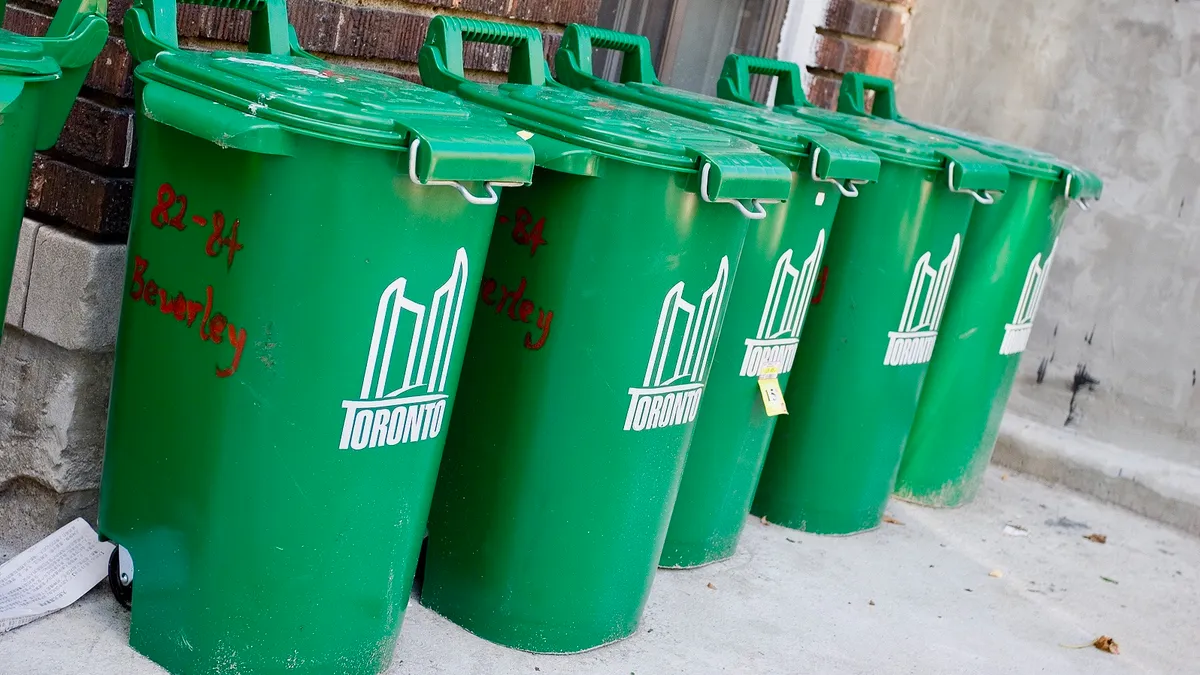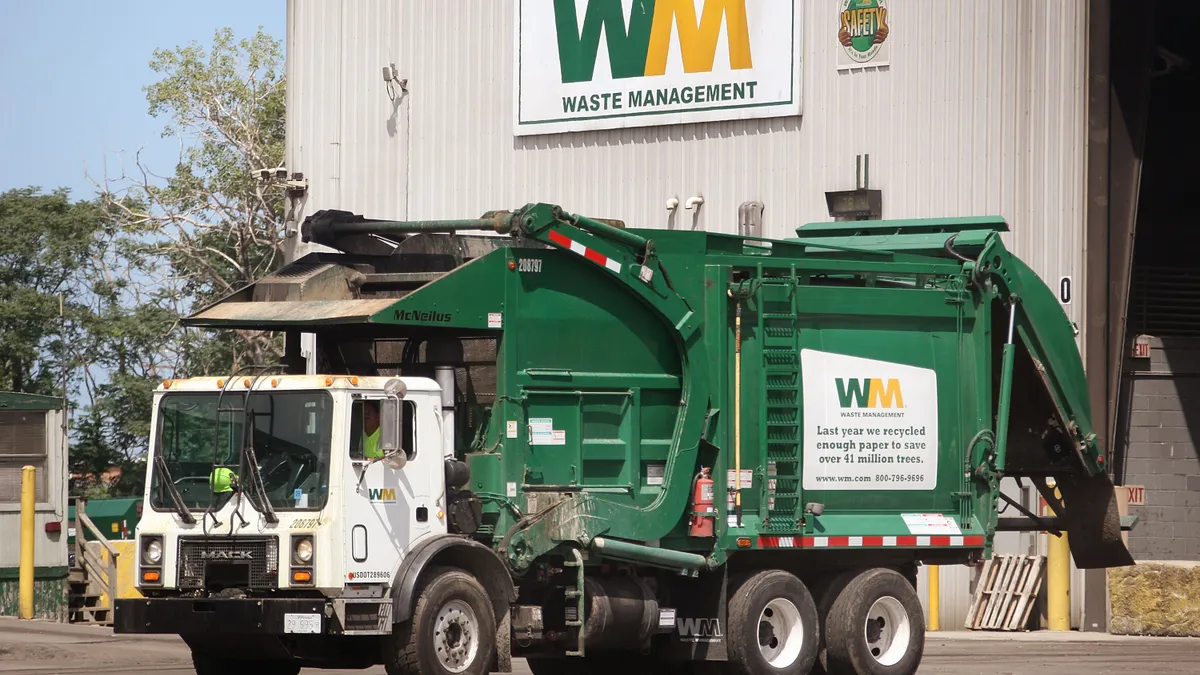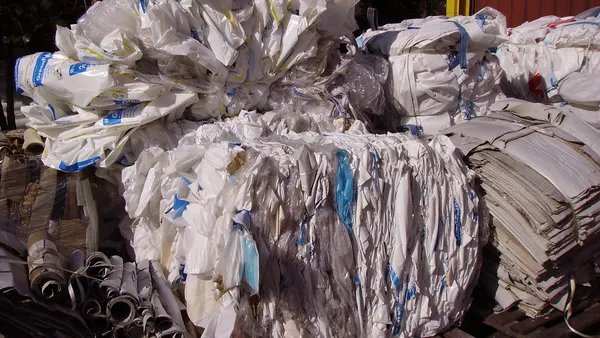As residential food scrap recycling programs in North America increase in number and scope, those in charge of scaling up organics infrastructure could do well by looking north to Canada for guidance.
In Canada, residential food scrap collection programs are well-established in many cities. The earliest began in Nova Scotia in 1998, following a provincial ban on putting residential organics into the garbage. Over the years, these programs have changed and expanded, allowing municipalities to learn what works, and what doesn’t.
A recent study from the Environmental Research & Education Foundation reports that 71% of Canadians have access to a curbside source-separated organics program, and 91% to any type of organics management program. In 2019, that amounted to 4.83 million metric tons of organic waste processed using composting and anaerobic digestion. Canada saw landfill diversion rates increase from 22% to 26% between 2002 and 2018, with greater residential access to organics programs cited as a key factor.
“That's a pretty significant win as it relates to broad scale programs,” said Tamara Shulman, director of community partnerships at Simon Fraser University’s Food Systems Lab.
Cities including Toronto, Vancouver and Halifax have residential food waste collection programs with high participation rates. One reason is because some have followed Nova Scotia’s lead and placed outright bans on putting food scraps into regular garbage. Prince Edward Island also has a ban and other provinces, including Ontario and Quebec, are considering them. British Columbia doesn't regulate waste at the provincial level, but previously had a goal of seeing enough regional food waste bans for 75% of the province’s population.
But bans aren’t the only way to go. Organics recycling professionals say the structural changes that make separating food waste for collection easy for residents are also important for participation.
Enforcement doesn’t usually mean a fine (although some cities, including Toronto, leverage fines as a last resort). But it does mean the resident has to correctly dispose of rotting food waste, and in some cases organics collection will be free while garbage collection is not. In cities such as Toronto, residents do have to buy tags for their garbage bins or bags.
Toronto collects food waste from single-family homes and around 60% of the city’s multi-unit buildings (the remaining 40% multi-unit buildings contract with private haulers). Current data has participation rates at around 90% for single-family buildings.
In 2020, 140,051 metric tons of material (not including yard waste) were collected in the city's green bin program, and processed by a combination of public and private contractors. It’s sent to the city’s anaerobic digestion facilities, where some is turned into biogas. About 70% of Toronto's collection fleet runs on compressed natural gas and renewable natural gas.
It’s important to make it easy for residents to compost, said Annette Synowiec, director of policy, planning and outreach for Solid Waste Management Services at the city of Toronto.
Toronto allows residents to put things like diapers and pet waste in their compost bins, as well as use plastic bags as liners, which are removed during pre-processing.
“I think the main drivers for that high participation is the lack of a barrier,” said Synowiec. “Not having to buy a certain compostable bag, or a paper bag or wrap in a newspaper, so that there's no financial barrier or no extra step that the resident has to take.”
Vancouver has a ban on putting food waste in the trash. The city, however, only collects from single-family and smaller apartment buildings. Multi-unit building managers have to manage food waste for their residents and coordinate private collection services.
Toronto and Vancouver both switched to biweekly garbage and recycling pickup, and weekly food waste collection. That schedule motivates people to put their food scraps in a compost bin, otherwise they would have to hold onto it for up to two weeks.
“The switching to biweekly garbage I feel is one of the most important things to do,” said Michelle Harris, a senior engineer at the Vancouver solid waste program's branch who worked on the food scrap program roll-out.
Bans and legislation also play important roles because they signal a larger societal change, said Shulman. But any residential food waste program must be structured so that it’s the easiest waste activity for people to do, she said, with very clear guidance.
“There has to be really specific how-to, because it's another behavior we're asking people to do on top of everything else they do related to waste management, and everything else in their lives,” said Shulman.
Contamination issues
While high participation rates are seen as a success, contamination remains a problem — and the biggest issue is plastics.
There are many products on the market right now that purport to be compostable, and even have certification labels, but they don't break down in facilities like Toronto’s anaerobic digesters.
“A large challenge right now is really trying to get the story straight on the management of these new innovative compostable products,” said Synowiec.
Biodegradable and compostable plastics are a complex issue. Some programs accept them, especially bags, as a means to an end—high participation rates. For others, compostable plastics are a hard no.
Halifax collects food waste for buildings up to six units, as well as condominiums. Almost 150,000 households are using the program. The collection is done by private contractors, and the material — 35,000 metric tons annually — is shipped to two composting facilities. A new facility to replace those two is scheduled to open in 2023.
According to Kirk Symonds, the team lead for education and program delivery with the city's solid waste resources division, a significant portion of Halifax’s food waste contamination is plastics. This mostly includes bags and bin liners, as plastic shopping bags are banned in Nova Scotia. He calls it the city food waste program’s biggest challenge.
Halifax tries to manage the plastic problem by visiting retailers to let them know these products aren’t accepted as part of the residential food waste collections program (although they can’t ban sales). In his view, the problem with accepting plastic is resistance from the public if they’re later told they can’t use it.
“In this case, you're better off to start off with your message, just saying no compostable plastic,” said Symonds. “We spend quite a bit of our energy and advertising focusing on that issue."
Successful strategies
For those who want to start a program, Vancouver’s Harris is a fan of pilot projects.
Theirs started with about 9,000 residents across 2,035 homes. It helped the city project an additional 80,000 questions to the city’s 311 info number from residents who wanted information about the program. They received 78,000 questions over the five-month program rollout, even though the city had sent out brochures and offered other education around the launch. They hired an additional 20 call takers just to deal with the volume.
“The pilot was really, really helpful in terms of making sure that we knew what to anticipate and where the points were that we're going to need extra support,” said Harris.
In 2019, Vancouver's program diverted 48,286 metric tons of organic material (including food scraps and yard) from disposal.
Synowiec believes in the value of a good story about circularity. Toronto’s residential food waste is all processed within city limits, so there are no long-distance shipping costs. There is also no methane generated from landfilling the material, and the city recently adapted an existing anaerobic digestion site so that it can produce renewable natural gas.
“I think that story is very relevant to a lot of residents right now,” said Synowiec. “I think that that kind of helps participation to some degree.”
Vancouver found success tackling contamination and compliance by sending inspectors to do neighborhood sweeps and tag bins that had the wrong things in them. Contamination rates decreased “pretty quickly,” said Harris.
Halifax set up call lines and a dedicated website, and uses social media to respond to questions. The city also uses geotargeting to direct social media messaging to areas where there are problems, which they know through a combination of curbside monitoring and information from haulers.
“It's a great tool,” said Symonds. “We're using all of that [information] along with social media technology to target those areas.”
As food waste collections become normalized for different generations and populations, Food Systems Labs’ Shulman thinks Canadian cities’ participation numbers can get even higher but added that the work of public engagement will never stop.
“You have to continually educate and have behavior change programs. We know that just having a brochure or seeing a blast of something on social media helps increase awareness, but it doesn't always change behavior,” she said.
After 23 years, Halifax’s program has matured but the messaging continues, said Symonds, and it’s not just the how, but the why that’s important.
“Why are we doing this? What is the point of it?" he said. "When you can explain to the public why we do this, they tend to buy-in a lot easier."


















